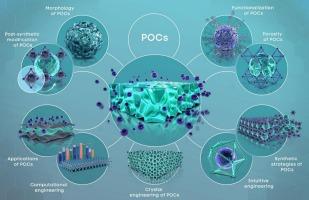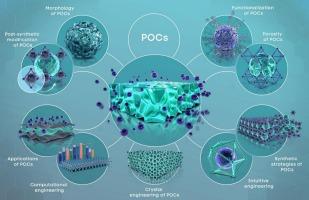The promise of porous organic cages: Bridging fundamental insights and real-world impact in energy and beyond
IF 23.5
1区 化学
Q1 CHEMISTRY, INORGANIC & NUCLEAR
引用次数: 0
Abstract
Porous organic cages (POCs) are an emerging class of materials defined by their unique molecular structure and high porosity, facilitating various applications in multiple domains. This review outlines the development of POCs from initial descriptions to modern advancements, emphasizing their distinct structural properties and implications for crystal engineering, such as polymorphism and modular cocrystallization. The strategic engineering of POCs is examined through instinctive and computational methods and synthesis strategies that use reversible and irreversible bond-forming techniques. Furthermore, post-synthesis modifications and functionalization strategies are explored, illustrating the adaptability of POCs in tailoring their properties for aimed applications. The morphology of POCs, including crystalline, hierarchical, and thin film structures, and their potential uses in photocatalytic and electrocatalytic processes, gas separation, membranes, molecular recognition, proton conductivity, and energy storage in batteries. This comprehensive overview of POCs underscores their potential as transformative materials in chemistry and materials science, encouraging further research and innovation to unlock their full capabilities and address modern challenges in energy, environmental science, and beyond. The insights provided herein aim to inspire new directions in the design and application of POCs, reinforcing their status as a significant advancement in porous materials.


多孔有机笼的前景:弥合基本见解和现实世界对能源及其他领域的影响
多孔有机笼(POCs)是一类新兴的材料,由于其独特的分子结构和高孔隙率,在多个领域得到了广泛的应用。本文概述了POCs的发展,从最初的描述到现代的进展,强调了它们独特的结构特性和晶体工程的意义,如多态性和模块化共结晶。POCs的战略工程通过本能和计算方法以及使用可逆和不可逆键形成技术的合成策略进行检查。此外,还探讨了合成后的修饰和功能化策略,说明了POCs在定制其特性以适应目标应用方面的适应性。POCs的形态,包括晶体结构、分层结构和薄膜结构,以及它们在光催化和电催化过程、气体分离、膜、分子识别、质子电导率和电池储能方面的潜在应用。对POCs的全面概述强调了它们在化学和材料科学领域作为变革性材料的潜力,鼓励进一步的研究和创新,以释放它们的全部能力,并应对能源、环境科学等领域的现代挑战。本文提供的见解旨在启发POCs设计和应用的新方向,巩固其作为多孔材料的重大进步的地位。
本文章由计算机程序翻译,如有差异,请以英文原文为准。
求助全文
约1分钟内获得全文
求助全文
来源期刊

Coordination Chemistry Reviews
化学-无机化学与核化学
CiteScore
34.30
自引率
5.30%
发文量
457
审稿时长
54 days
期刊介绍:
Coordination Chemistry Reviews offers rapid publication of review articles on current and significant topics in coordination chemistry, encompassing organometallic, supramolecular, theoretical, and bioinorganic chemistry. It also covers catalysis, materials chemistry, and metal-organic frameworks from a coordination chemistry perspective. Reviews summarize recent developments or discuss specific techniques, welcoming contributions from both established and emerging researchers.
The journal releases special issues on timely subjects, including those featuring contributions from specific regions or conferences. Occasional full-length book articles are also featured. Additionally, special volumes cover annual reviews of main group chemistry, transition metal group chemistry, and organometallic chemistry. These comprehensive reviews are vital resources for those engaged in coordination chemistry, further establishing Coordination Chemistry Reviews as a hub for insightful surveys in inorganic and physical inorganic chemistry.
 求助内容:
求助内容: 应助结果提醒方式:
应助结果提醒方式:


